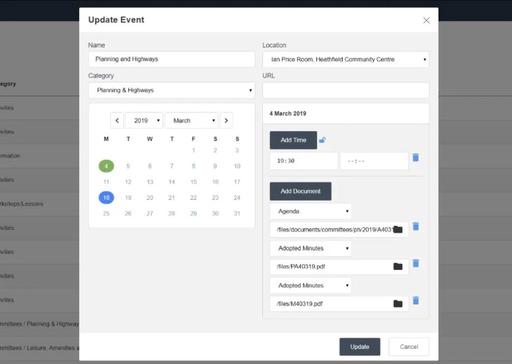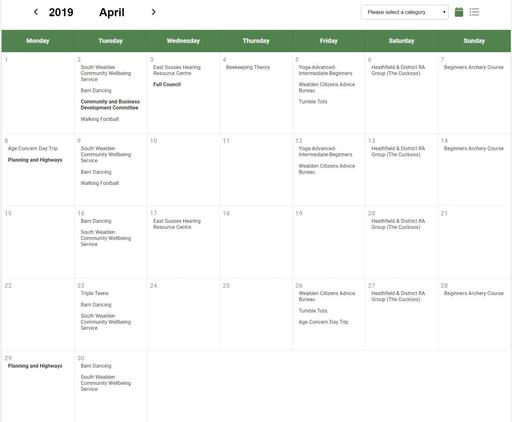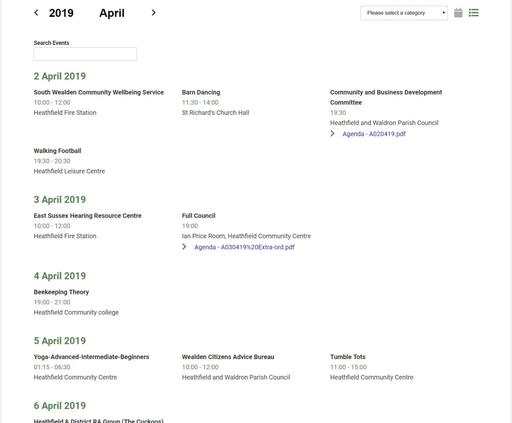Build
Quite early on in the project we had the design template built on Jolojo CMS and started adding in the content. We used normal pages for the non categorised content and the Jolojo blog engine to create categories (e.g. Local information) for categorised content. It was then a simple task of adding blog pages to these categories (e.g. Schools, Doctors, Library etc.)
We did the majority of the content porting but also used this phase as a training exercise and tasked our client with assisting in this process.
Using the Jolojo URL mapping system we made sure that any old URLs were mapped to the new URL and forwarded on a 301 HTTP header. This tells Google and other Search Engines (yes there are others..) that the old URL has been moved permanently to a new URL.
Calendar Development
It was at this stage that we handed over the Calendar functionality for beta testing. This proved to be very interesting as it is one thing conceptualising functionality but quite another seeing it being used and listening to users feedback (and yes, seeing how users can break your lovely new feature in ways you never imagined it would be used). We went through three revisions, tweaking and improving until we and our client was happy with the ease of use, error catching and stability.
Events can be singular (e.g. a one off Flower Show) or a series (e.g. Committee Meetings) and can have documents attached to each meeting date or link to a bespoke URL. It is possible to add a whole year of Council meetings in just a few minutes. Agendas and Minutes can then be added at a later date.
Here is a screen shot of the Calendar function in action where documents have been added to an Event (in this case a planning meeting).

The calendar display plugin then has different modes:
A month grid view (displaying all categories, which can additionally be filtered.)

A month list view (displaying all categories, which can additionally be filtered.)

Each of the events then links to either an automatically generated page to display common information (such as meeting location) and documents or a user selected page which can contain further and more detailed information about the event.
The calendar display can also be placed on any page to display just the events that are associated with that type of meeting (this is used for the individual committees for this client.)
Profile engine development
As a council with elected councillors there is a statutory duty to display information about those elected. The information required includes contact details and a register of members interests so the public are aware if there is a potential conflict of interest. Additionally we wanted to add a photograph, what electoral ward they were elected from and the membership and position of committees they serve on.
We didn't have time to build in a profile engine for the launch of the website (this also needed careful planning as we will use the profile engine on other site for different reasons), so added the councillors to the site manually (in individual text plugins that could be used on multiple pages.)
Accessibility
Public body websites also have a requirement to make their websites accessible to WCAG 2.1 AA standards. There is no 100% accurate automatic checking tool to do this, indeed the gov.uk website states that an audit for a public body to asses this standard should cost between £3,000 and £7,000 - https://www.gov.uk/guidance/accessibility-requirements-for-public-sector-websites-and-apps - the basis of the standard are sound (the website should be accessible to all), it can mostly be satisfied technically but is also requires examination and use by Screen Readers and users with disabilities.
The majority of this standard has already been satisfied, but we will be adding in:
In file manager Title attributes for PDF documents
Minor technical tweaks
Testing by real people
We are committed to ensuring that this standard is met as closely as possible, and as the platform will be sold to other councils this will be done 'beyond doubt'.
We would not normally make a website live knowing that there were accessibility issues to be solved, but as stated above this is a very in depth standard and is not the work of a moment to understand yet implement a robust solution.
We will also be offering regular audits (1, 3, 6 or 12 monthly) including Jolojo tools to automatically check common issues (e.g. Alt and Title tags on images - but even this can only be used to check that they are present, not that they are written correctly as designed by the W3C consortium and part of HTML standards).
Ready for Live
Once all the pages had been built and our rigorous and imperative internal sign-off documentation and checking procedure had been completed, which makes sure that the site is working as expected on all specified devices, browser types and sizes, contact forms are being sent and received plus over 50 other checks. Although this checking system takes up to a day, it ensures there are no post live crises and ensures everyone sleeps well! We were then ready to push the big green GO button.
Post Live
Launching a new or revised website is not the end of our work, we make sure that the site is working as intended and expected.
Post live checks ensure that Google Tag Manager is reporting properly to Google Analytics, Google Search Console is monitored for any stray old URL requests (which can happen if old websites are linking to legacy pages from even older versions of the website we maybe unaware of) and issues.
We further run our Rank Tracking software measuring the effectiveness of the site in the Google index against a baseline of rankings that were established pre-live. As we designed and built Jolojo, it is very effective in the Google index and we only see improvements when porting sites to this platform.
Conclusion
This is a great example of how we can work with a client with an 'idea' of what they want, help evolve this idea, bring new working practices to their organisation and then deliver really efficient functionality.
Working on Jolojo as core gave us an excellent head start and has proved to be a much better and easier to use platform for the client. As we continue to evolve the core of Jolojo the client will benefit.
We are identifying further usability improvements and encourage regular contact and feedback.
www.hwpc.org.uk



